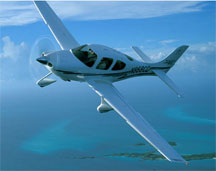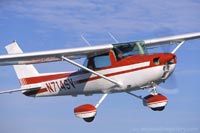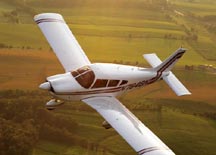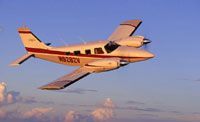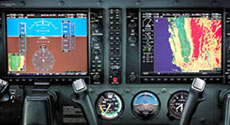PRIVATE PILOT CERTIFICATE
You’d like to learn how to fly. And you’ve got questions. So we’ve included a helpful FAQ that should provide the answers you need. Feel free to call us at 510-887-7686, email us, or stop
by our office during business hours (9 am to 6 pm, 7 days a week) for more information.
Why learn how to fly?
Once you’ve taken to the skies at the controls of an airplane, you’ll never look at the world in quite the same way. Imagine leaving the Bay Area on a busy Friday afternoon, speeding over the choked-up freeways below, and landing in Tahoe less than an hour later. Or heading to L.A. for the weekend, without dealing with overbooked airlines, lost luggage, and all the hassles of airline travel. Or you could simply take your friends on an awe-inspiring aerial tour of the beautiful Bay Area. In fact, once you have your private pilot certificate, you can pretty much fly anywhere in the world you want. You set your own schedule, enjoy the freedom of the skies, and witness gorgeous views that are far better than those you’ll get on an airliner. And if you share the cost of the flight with your friends, you can often fly somewhere for less than you’d pay for a coach-class ticket.
For more information on learning to fly, read the rest of our “Learn to Fly” section, or visit www.beapilot.com.
Is it safe?
No human activity is perfectly safe. But despite all the overblown news stories to the contrary, flying is simply the world’s safest form of transportation. General aviation fatalities occur approximately once every 100,000 hours of flight time, which means you’d have to stay in the air for eleven straight years (that’s 24 hours a day, 365 days a year) before you’d be likely to die in an accident. To put that in perspective, even senior airline captains don’t log much more than 20,000 hours in an entire lifetime, while most non-professional pilots will log much less. At California Airways, we pride ourselves on our perfect safety record. Our aircraft are stringently maintained to FAA standards, and our veteran instructors have logged thousands of accident-free hours.
How difficult is it?
Flying isn’t as difficult as most people think. While it’s admittedly more complicated than driving a car, it’s still within the grasp of most people. Of course, experienced flight instructors make a huge difference. Our seasoned instructors have taught hundreds of people how to fly, ranging from 15-year-old high-school students to 75-year-old retirees. If you’d like to see for yourself, take an introductory flight with us. You’ll fly the airplane from the pilot’s seat, with your instructor assisting you. It’ll open up a world you probably never knew existed.
How long will it take?
That depends on how often you fly. The average person logs 65 hours of flight time before earning the private pilot certificate. If you fly twice a week, and log 1.5 hours of flight time per lesson, you should be finished in six months or less. Of course, you can fly more often if you prefer, and earn your certificate quicker.
How much will it cost?
Since every student has different skills, it's difficult to provide an exact cost number. However, assuming that you train in a Cessna 152 and complete your flight training in the average time, you can expect to spend approximately $9,000 to earn your private pilot certificate.
I am not a U.S. citizen. Can I learn how to fly with California Airways?
Yes. But you must first complete the Transportation Security Administration's verification process. Visit the TSA web site and register as a "Candidate" for the Alien Flight Student Training Program. Select California Airways, Inc. as your course provider. TSA approval must be granted before you begin training. TSA approval is required for all non-citizens, even if
you have a green card and are a legal U.S. resident.
I am not a legal U.S. resident. Can I learn how to fly with California Airways?
Yes. In addition to TSA approval, you will need an M-1 student visa before you arrive in the United States. We issue I-20 sponsorship forms for the M-1 visa. Click here for application information.
What is the difference between "Part 61" and "Part 141" training?
The numbers refer to the parts of the Federal Aviation Regulations under which your training is conducted. We are authorized to conduct training under either Part. Generally, Part
141 training follows a predefined format and requires students to attend formal ground school. Under Part 61, formal ground school attendance is not required. The advantage of Part 141 is that it theoretically allows you to complete your training in fewer hours than Part 61. For example, only 35 flight hours are required under Part 141 to earn a private pilot certificate, whereas Part 61 students must fly at least 40 hours. For a commercial pilot certificate, Part 141 students only need 190 hours, instead of 250 hours under Part 61. However, these hours are only the required minimums. Realistically, additional training will be required beyond
the minimums.
If you are not a legal U.S. resident, you will require an M-1 student visa. You must enroll in
a Part 141 program. Part 61 training is only available to legal U.S. residents.
Can I wear glasses and still fly?
Yes. Many pilots wear glasses, including bifocals or trifocals. To fly an airplane solo (or with passengers,) you must pass a simple FAA exam. Assuming you’re in fair health, you should pass the exam. Special medical exemptions are possible. There are plenty of deaf pilots and even paraplegic pilots flying today. (There aren’t any blind pilots, however.)
How old do I have to be?
To fly an airplane solo, you must be at least 16. To earn your private pilot’s certificate (which allows you to carry passengers), you must be at least 17. You can start training before you turn 16; in fact, our owner (Keith Amaro) and our chief flight instructor (Kareem Fahmi) both soloed on their 16th birthdays.
There is no maximum age limitation for starting flight training. We have trained student pilots in their mid-70s.
Do I have to attend ground school?
While you do have to study certain aviation textbooks, you’re not required to attend a formal ground school unless you are enrolled in one of our Part 141 training programs. You can study the material at your own pace and conduct review sessions with your instructor. Or, if you prefer, you may attend a scheduled ground school. Ask us for more information.
What does the exam for the private pilot’s certificate involve?
There are three parts: the written, oral, and flight tests. The written test is a 60-question, multiple-choice, computerized test, which our staff is certified to administer. After you’ve passed the written, and your instructor certifies that you’re prepared for the oral and flight tests, a Designated Examiner will administer the final exam, or “checkride.” The oral exam lasts about 90 minutes, while the flight exam lasts about 1 hour and 45 minutes. If you meet the performance standards, congratulations! You’ll be issued your license that same day. Nationwide, 90% of applicants pass their private “checkrides” on the first try. That’s not to say that the exam is too easy. But it does show that a proper training program, administered by professional flight instructors, yields excellent results.
What can I do with a private pilot’s license?
Just about anything you can imagine! Here’s a sample list:
While weekend trips might sound expensive, you don’t pay for every hour that you have the airplane. You only pay for the time the engine is running, so weekend trips are actually quite affordable. (We do have hourly minimums for weekend trips, however.)
While you won’t be able to fly for hire until you have your commercial certificate, or fly inside clouds until you have your instrument rating, the private pilot certificate grants you access to a magical, beautiful world in which traffic jams have no meaning, sunsets last forever, and birds look upon you as equals.
How do I become a California Airways member?
It's easy! Click here for more information. There's no initiation fee (unlike most Bay Area flight schools), and dues are only $25 per month, charged only in the months that you fly.
Most other flight schools charge dues every month, even if you don't fly every month. Customers who purchase our training packages are exempt from club dues for the duration of their training package.
